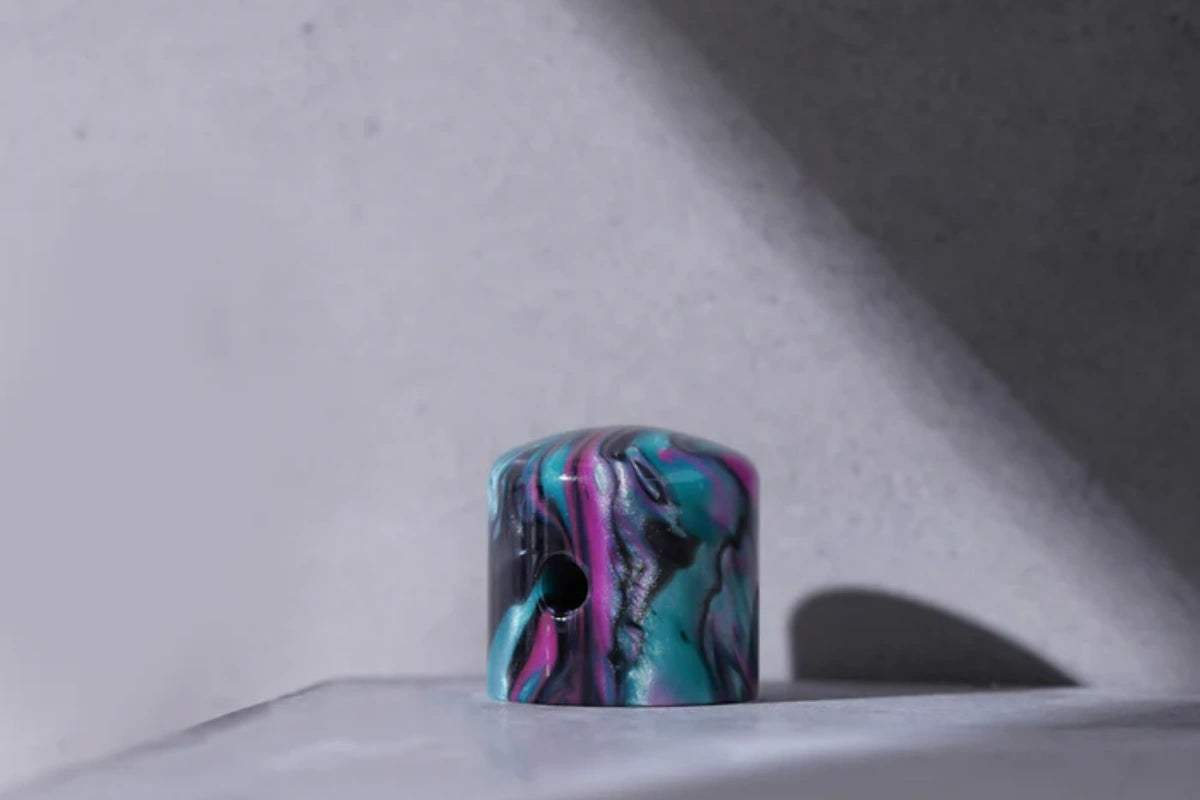Welcome to the third part of this journey straight to the core of electric guitar pickups. In this episode, we’ll talk about P-90s, mini-humbuckers, hybrid configurations, and the effect wire gauges and turns have on gain and tone.
Even if you don’t own a guitar with these kinds of pickups, it’s important to know where they can take your instrument. Sometimes, we have a specific tone in our heads and just don’t know how to replicate it.
Well, perhaps, a new set of pickups you never played with might be the tone experiment you needed to get the dream tone you’re after.
So, without further ado, let’s get to it!
Wire Width and Turns
In the first stop of this journey, we talked about the very basic knowledge about pickups, like pickups being electromagnetic devices creating magnetic fields. These fields “read” the disturbances caused by the strings and make the sound. The magnets need to be wrapped in wire to create the magnetic field.
This is common to every passive electric guitar pickup.
We’ve talked about one of the components, magnets. But does the wire thickness and number of turns affect gain, tone, and sound?
The answer is yes.
Read on to find out how and why.
More Means More, Less Is a Bore
The line above belongs to the architect Robert Venturi, part of the maximalist movement. The opposite of the minimalist movement and Marie Kondo’s archrival.
But why is that quote here? Well, as a rule of thumb, the more turns a pickup has, the stronger the magnetic field, thus, the more powerful the pickup will be.
Well, it doesn’t work only that way, there are certain side effects to this phenomenon. The main one is that the number of turns changes the pickup frequency spectrum. Yes, if you add more turns to a pickup, the extra power will be in the midrange while bass and treble will be attenuated.
So, on one hand, you can make the pickup more powerful in terms of output, but if you play, for example, on a metal band, you need that low end to lock the rhythm to the kick drum.
Therefore, if you like the sound of a pickup but would like to make it hotter, increasing the number of turns will also change its tone.
What about the Gauge of the Wire?
The gauge of the wire is part of the equation here for a very simple reason: it defines how much space it occupies. Let’s look at some scenarios:
• Making a Pickup Hotter – Let’s say you want to make a pickup from your Stratocaster hotter. Well, Fender single-coil pickups can typically fit around 8,000 turns of 42-gauge wire. If you want to make it hotter, aka add more turns, you need to use 43 or 44-gauge wire instead.
• Matching Pickups – Another great example of wire gauge importance is the Telecaster. The neck pickup needs to fit enough turns to compete with the bridge pickup in a much smaller space. Therefore, Fender has traditionally always used 43-gauge wire for that specific case.
You might be thinking, how does this affect tone? Well, as you know, tone is the unique outcome of the sum of all the parts between the pick and the speaker. In terms of wire gauge, the difference is small but noticeable enough to make a pickup likable for you or not.
For example, for those who swear by the early Fender Broadcaster bridge pickup released in 1950, that fatness behind the bright edge of the pickup’s bite is the 43-gauge wire. New Telecaster pickups are made with 42-gauge wire and offer a more defined, tighter, clearer twang.
The Oddballs, P-90s and Minihumbuckers
You must have heard and played through Fender-style single-coil pickups and humbuckers, but what about the rest of the pickup models in the market? Well, let’s look at the oddballs, the not-so-known pickups that can transform into your secret weapon.
Yes, tone chasing is a lifetime endeavor, but knowing what each pickup type sounds like allows you to find shortcuts to wherever you want to go.
What Are P-90 Pickups?
The first thing you must know about P-90 pickups is that they’re single coils. Indeed, they were created by Gibson in 1946 to replace the heavy cobalt pickup known as the Charlie Christian pickup. That one had been around since the 1930s and was wounded using 38-gauge wire.
Each of those weighed around 2lb. That’s way too much to have two installed in a guitar.
So, after WWII was over and Gibson resumed making musical instruments, they came up with the P-90. You can find it on every model until they were debunked by the hum-free humbuckers in 1957.
P-90 pickups are single coils, and therefore, are susceptible to 60-cycle hum. The wire used for this pickup was a 42-gauge wire. Does it ring a bell? Yes, the guitar tone is beginning to standardize. Also, instead of using heavy cobalt, the magnet used was Alnico.
In summary, P-90 pickups are Gibson’s version of the single-coil pickup. As we said in the first article of this series, the shape and structure of the P-90s are different from that of a Fender-style single-coil pickup. While Fender used Alnico magnets as pole pieces, P-90s use magnets on the bottom connected to a set of screws you can see on the top of the pickup.

How do P-90s sound? Well, read on and find out!
Understanding Tone & Gain
The first thing to say about P-90s when comparing them with Fender-style single-coil pickups is that they lack the definition and the glass-like clarity of the Fender pickups. This is because of the pickups’ structure and design.
As a side effect of this difference, the P-90 has more “bite” which translates into a low and midrange bump.
But that’s not all, because the pickup’s shape is also something that affects the resulting tone and that’s important to bear in mind. The P-90 structure is wider and flatter than that of a regular single-coil pickup. This means that the magnetic field it creates is also wider.
Since the magnetic field is wider, it captures more of the string movement. This means the P-90 picks up more of the low and low-mid frequencies. As a result, what you hear is a pickup with less edge and more fatness. Furthermore, the wider range also provides more sustain since the oscillation doesn’t have the sharp decay Fender-style single-coil pickups have.
Finally, a regular P-90 pickup has enough space to pack more turns of 42-gauge wire. That feature coupled with the wider magnetic field gives you a powerful pickup judged by single-coil pickup standards.
Some P-90 characteristics:
• Power – Although it is a single-coil pickup, a P-90 packs more power than most regular single-coil pickups.
• Low-end – The wide design of the pickup allows for a wider electromagnetic field. This translates into a thick low end and more bite in the low mids.
• 60-Cycle Hum – P-90s might be hotter and more powerful than Fender-style single-coil pickups but they share the same 60-cycle hum. Therefore, P-90s, when coupled with lots of distortion tend to be very noisy.
Get P-90s if You
P-90s are exceptional rock and roll pickups. You can think of the midrange and bite of guitar tones such as Keith Richards or Neil Young. Also, young Carlos Santana played P-90 pickups for the first three albums as well as John Lennon, Bob Marley, and Robbie Krieger, among many others.
What you get is the edge and treble response of a single-coil pickup to cut through the mix coupled with a little more oomph that can push the tone into the overdrive zone and drive a band forward.
So, if you like the definition and edge of a single-coil pickup but would like to add more body to the sound without losing the bite, P-90s are an amazing choice.
On the other hand, if you’re looking for a way to add more gain to your guitar to play styles like heavy metal, thrash, and its derivates, they might be a little too noisy. Also, they tend to have too much bite for the ultra-clean neo-soul and trip-hop tone.
They are a great match for mahogany-body guitars.
What Are Mini-humbuckers?
Mini-humbuckers, as their name indicates, are miniature-sized humbucking pickups. But that’s not the entire story about these pickups from a tone perspective because, as we said before, the structure, magnet, winding, and construction affect the resulting tone.
As you would expect, these pickups sound different from everything else we’ve talked about this far. They do have a space sonically and physically between single coils and humbuckers, but it’s a sonic space entirely of their own.
Where do mini-humbuckers come from? Well, they weren’t created by Gibson but by Epiphone. When Gibson bought the company, the combo included the patents for the design. Therefore, Gibson started using these pickups on most Epiphone models released.
For example, the Riviera (played by Caleb Folowill from Kings of Leon) features mini-humbuckers instead of full-sized humbuckers or P-90s. The pickups set the Riviera apart from the Casino (P-90s, Lennon’s guitar) and the ES-335 (humbuckers).
But the breakthrough for these pickups came in 1968 when Gibson decided to use the old stock of mini-humbuckers they had from the early Epiphone days to release the Les Paul Deluxe. These were bodies routed for P-90s (that’s why most of them are gold tops) with these humbuckers that only needed a custom frame to fit the P-90 space.
Although the Les Paul Deluxe was sold as a more affordable version of the Les Paul, the unique tonal qualities of the pickup created an instant classic.
But how do mini-humbuckers sound, feel, and play? Well, read on and find out!

Understanding Tone & Gain
Mini-humbuckers sit comfortably between a humbucker and a P-90. Do you remember how P-90s occupy more space physically and thus pick up more of the string movement over the magnetic field and generate a more generous low and low-mids response?
Well, since the space mini-humbuckers occupy is slightly smaller than that of a regular humbucker, the effect is the opposite. What you get is a more tamed but tight low-end and a clearer, sparkly high-end response.
Also, since the pickup’s iron content is lower (because of the size), the pickup offers better string definition, lower output, and a certain jangle in the high-end that’s very particular. That air and definition can be heard all over ‘70s-era rock.
If you’ve ever heard Thin Lizzy’s Live and Dangerous live album, you’ve heard two Les Pauls playing the same riff at the same time, one with humbuckers and the other with mini-humbuckers.
If you have a decent pair of headphones or a stereo sound system, pay attention to the first song, “Jailbreak” and you’ll hear Scott Gorham playing mini-humbuckers on your right and Brian Robertson playing humbuckers on your left.
One of the guitars brings the oomph, the low-end-based power, and most of the dirt while the other brings the edge, the bite, and the mid-gain treble-oriented tones.
So, in summary, mini-humbuckers characteristics are:
• Clear and Defined – Since the low end is tamed, string definition improves when compared to regular, full-sized humbucker pickups.
• High-end Oriented Tone – Because of the mini-humbucker’s size, the electromagnetic field covers a smaller portion of the strings’ movement. Therefore, the low-end drops, and a unique high-end response appears. This is also something you notice as you play, these are more percussive and responsive than regular humbuckers.
• Silent Operation – Since mini-humbuckers utilize two coils, they cancel the 60-cycle hum single-coil pickups generate. Therefore, they work great adding definition to a high-gain scenario.
Get Mini-humbuckers if You
Mini-humbuckers are perfect for those who want to bring more definition and high-end response to an aggressive, high-gain tone. Yes, they’re the perfect choice for breathing new life on that mahogany-made guitar that needs to come out of a muddy low-end.
Another great use for mini-humbuckers is to add more punch while retaining definition and edge. For example, a guitar with a P-90 or a single-coil pickup could become a rocking machine without any annoying hum or noises retaining the percussiveness and high-end response with a mini-humbucker.
Finally, they make a great bridge pickup for a guitar with a P-90 or a full-sized humbucker in the neck position. That’s because of the mix of mid-gain, sparkling highs, and a tight but tamed low-end.
What About Hybrid Pickup Configurations?
Before wrapping the third leg of our journey, let’s talk about hybrid configurations. Why are they important? Well, they can help you cover more sonic ground with a single instrument.
For example, if you need a guitar that can do the Strat thing but also the high-gain thing, you need a guitar with an HSS configuration. That means a humbucker in the bridge position and two single-coil pickups for the middle and the neck. That way, you can go from SRV to EVH with the pickup selector and a distortion pedal.
But it doesn’t end there, you could have an SH configuration like Keith Richards has on his Telecaster. He can go from twangy, rocking, clean, and jangly tones to full-bodied, blues-approved oomph in the neck.
Finally, now that you’ve seen what P-90s and Mini-humbuckers can do, a guitar like Neil Young’s Old Black makes much more sense. The mini in the bridge cuts through the mix with gain and sparkle while the P-90 in the neck gives the thickness and growl Neil needs.
So, don’t be afraid to experiment since hybrid configurations can open the door to a much broader tonal palette for any instrument.
Conclusion
The oddballs, the weird ones, the outcasts, the not-so-well-known, the hidden gems, those are the kind of tones we all look for in our musical career. Sometimes, moving out of the beaten path can turn out to be the most productive and inspiring in terms of tone searching.
So, now that you know all the types of passive electric guitar pickups, you have enough data to make an informed decision and take your playing to the next level.
On our last stop of this trip, we’ll talk about active pickups and whether you should get a set for your instrument.
Happy (odd and amazing) playing!
If you like this article, please share it!
Be sure to join our FB Group Guyker Guitar Parts VIP Group to share your ideas! You can also have connections with like-minded guitar players, Guyker updates as well as discounts information from our FB Group.





